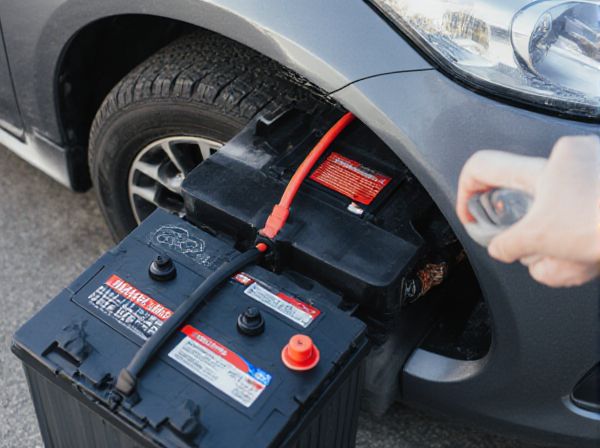
Photo illustration: Gel Cell vs Enhanced Flooded
Gel cell batteries offer maintenance-free operation with a sealed design that prevents electrolyte spills, making them ideal for deep cycle use and harsh environments. Enhanced Flooded Batteries (EFB) improve on traditional flooded batteries by incorporating advanced plates and separators for better cycling performance and longer life in start-stop vehicles. Your choice depends on whether you prioritize durability and low maintenance (gel cell) or cost-effectiveness and stronger starting power (EFB).
Table of Comparison
| Feature | Gel Cell Battery | Enhanced Flooded Battery (EFB) |
|---|---|---|
| Electrolyte Type | Silica-based gel | Liquid acid with additives |
| Durability | High resistance to vibration and shock | Improved lifespan over standard flooded |
| Maintenance | Maintenance-free | Low maintenance |
| Performance in Extreme Temperatures | Excellent in high heat | Good, but less heat tolerant than Gel |
| Deep Discharge Recovery | Excellent recovery from deep discharge | Moderate recovery capability |
| Cost | Higher upfront cost | Lower cost, budget-friendly |
| Application | Ideal for off-road and marine vehicles | Common in start-stop and standard cars |
Introduction to Gel Cell and Enhanced Flooded Batteries
Gel cell batteries utilize a silica-based gel electrolyte, providing enhanced vibration resistance and improved performance in deep discharge cycles compared to traditional flooded batteries. Enhanced flooded batteries (EFB) feature reinforced separators and thicker plates, increasing charge acceptance and lifespan, particularly in start-stop automotive applications. Both battery types cater to specific energy demands, with gel cells excelling in maintenance-free, stable power delivery and EFBs optimized for high-cycle durability and rapid recharging.
Technology Overview: How Gel Cell Batteries Work
Gel cell batteries use a silica-based gel electrolyte that immobilizes the sulfuric acid, preventing spills and improving durability in deep cycle applications. This gel composition allows for better resistance to vibration and temperature extremes compared to Enhanced Flooded Batteries (EFB), which rely on a liquid electrolyte to facilitate ion exchange during charging and discharging. Gel cells offer slower self-discharge rates and enhanced performance in maintenance-free conditions, making them suitable for applications requiring long service life and consistent power delivery.
Understanding Enhanced Flooded Battery (EFB) Technology
Enhanced Flooded Battery (EFB) technology improves traditional flooded lead-acid batteries by incorporating carbon additives and reinforced plates, resulting in better charge acceptance and longer cycle life. EFB batteries offer enhanced durability and superior performance, especially in start-stop vehicle applications with frequent engine restarts. Their design provides a cost-effective alternative to Gel Cell batteries, balancing improved energy efficiency with reliable power delivery.
Key Differences Between Gel Cell and EFB Batteries
Gel Cell batteries use silica-based gel electrolyte, providing enhanced vibration resistance and better performance in deep-cycle applications, while Enhanced Flooded Batteries (EFB) improve on traditional flooded lead-acid designs with reinforced grids and acid stratification prevention for better charge acceptance and longer cycle life. Gel Cells excel in maintenance-free operation and resistance to spillage, making them ideal for off-road and marine use, whereas EFB batteries deliver higher charge efficiency and endurance in stop-start automotive systems. Temperature tolerance also differs, as Gel Cells perform better in extreme conditions but may have slower charge rates compared to EFB batteries optimized for rapid recharge cycles.
Performance Comparison: Gel Cell vs Enhanced Flooded
Gel Cell batteries offer superior vibration resistance and better deep cycle performance compared to Enhanced Flooded Batteries (EFB), making them ideal for high-demand applications. EFB batteries provide improved charge acceptance and longer life cycles over standard flooded types but generally fall short of the durability and maintenance-free advantages found in Gel Cells. In scenarios requiring stable performance under extreme temperatures and minimal maintenance, Gel Cell batteries outperform EFB models in reliability and overall lifespan.
Lifespan and Durability Analysis
Gel cell batteries exhibit a longer lifespan than enhanced flooded batteries, typically lasting 5 to 7 years compared to 3 to 5 years. The gel electrolyte structure in gel cell batteries provides superior durability against vibration and deep cycling, reducing maintenance needs. Enhanced flooded batteries, while cost-effective, are more prone to corrosion and water loss, which can shorten their operational life under harsh conditions.
Maintenance Requirements for Each Battery Type
Gel cell batteries require minimal maintenance due to their sealed design and non-spillable electrolyte, eliminating the need for water refilling and reducing the risk of acid leakage. Enhanced flooded batteries demand regular maintenance, including checking electrolyte levels and topping off distilled water to prevent plate exposure and ensure optimal performance. Neglecting maintenance in enhanced flooded batteries can lead to reduced lifespan and efficiency, whereas gel cells provide a more hassle-free experience for applications requiring reliable, low-maintenance power sources.
Cost Considerations: Initial Investment and Long-Term Value
Gel Cell batteries typically have a higher initial investment compared to Enhanced Flooded Batteries (EFB) due to advanced construction and longer lifespan. EFB batteries offer lower upfront costs but may require more frequent replacement, impacting overall long-term expenses. Evaluating total cost of ownership reveals Gel Cell batteries often provide better value over time despite their higher price, thanks to enhanced durability and maintenance reduction.
Applications and Ideal Use Cases
Gel cell batteries excel in applications requiring deep cycling and vibration resistance, making them ideal for off-grid solar systems, wheelchairs, and marine use. Enhanced Flooded Batteries (EFB) perform well in start-stop automotive systems and light commercial vehicles, offering improved charge acceptance and cycle life over traditional flooded batteries. The choice between gel and EFB depends on the demand for maintenance-free operation and specific energy discharge patterns in the intended application.
Choosing the Right Battery: Factors to Consider
Choosing the right battery between Gel Cell and Enhanced Flooded involves evaluating factors such as maintenance requirements, performance in extreme temperatures, and lifespan. Gel Cell batteries offer superior resistance to vibration and deeper discharge capabilities, making them ideal for off-grid and marine applications, while Enhanced Flooded batteries provide higher charge acceptance and lower initial cost, suited for automotive and backup power systems. Consider the specific use case, environmental conditions, and budget constraints to ensure optimal battery performance and longevity.
 caratoz.com
caratoz.com